Imagina escribir la publicación de blog perfecta, pero nadie la lee simplemente porque Google no sabe que existe. Este es un temor común para muchos propietarios de sitios web, pero la solución es más simple de lo que podrías pensar. Necesitas una forma de decirle a los motores de búsqueda exactamente dónde buscar.
Un mapa del sitio XML actúa como un mapa de ruta para tu sitio web. Guía a Google a todas tus páginas importantes para que puedan ser indexadas y mostradas en los resultados de búsqueda.
En WPBeginner, usamos All in One SEO para generar nuestros mapas del sitio automáticamente. Esto asegura que nuestro contenido sea descubierto inmediatamente después de publicarlo.
En esta guía, explicaremos qué es un mapa del sitio XML y cómo crear uno en WordPress para mejorar tus rankings de búsqueda.
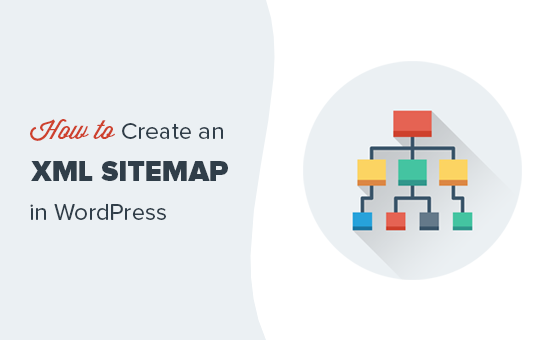
¿Qué es un mapa de sitio XML?
Un mapa de sitio XML es un archivo estructurado que actúa como un mapa detallado de tu sitio web, enumerando todas tus páginas importantes en un formato que los motores de búsqueda pueden leer y entender fácilmente.
Si tu sitio web fuera una biblioteca, entonces un mapa de sitio XML sería el catálogo de fichas que ayuda a los bibliotecarios (motores de búsqueda) a encontrar qué libros (páginas) están disponibles y dónde se encuentran.
El concepto no es completamente nuevo. A principios de los años 2000, muchos sitios web incluían páginas de mapa de sitio HTML con enlaces a todo su contenido importante. Estas estaban diseñadas para que los visitantes humanos navegaran por el sitio más fácilmente.
Los mapas de sitio XML evolucionaron de esta idea pero cumplen un propósito diferente. En lugar de ayudar a los visitantes humanos, están diseñados específicamente para comunicarse con los rastreadores de motores de búsqueda como Googlebot, el rastreador de Bing y otros.
Tu mapa de sitio XML le dice a los motores de búsqueda varias piezas cruciales de información:
- ¿Qué páginas existen en tu sitio web?
- ¿Cuándo se actualizó por última vez cada página?
- ¿Con qué frecuencia sueles actualizar páginas específicas?
- La importancia relativa de las páginas en comparación con otro contenido de tu sitio
Esto es lo que muchos propietarios de sitios web no se dan cuenta: los sitemaps XML no mejoran directamente tu posicionamiento en buscadores. Sin embargo, facilitan que los motores de búsqueda descubran e indexen tu contenido.
Cuando los motores de búsqueda pueden encontrar y entender mejor tus páginas, es más probable que veas esas páginas aparecer en los resultados de búsqueda, lo que en última instancia conduce a un rendimiento SEO mejorado y un aumento del tráfico orgánico.
Por qué necesitas un sitemap XML
Los sitemaps XML juegan un papel importante en la estrategia de optimización para motores de búsqueda (SEO) de tu sitio web, especialmente cuando se trata de ayudar a los motores de búsqueda a descubrir y entender tu contenido.
Los motores de búsqueda son increíblemente inteligentes, pero no leen la mente. Sin la orientación adecuada, podrían pasar por alto páginas importantes de tu sitio web o tardar mucho más en encontrarlas.
Importante para sitios web nuevos
Los sitemaps XML son especialmente valiosos cuando inicias un blog o crea un sitio web nuevo. Los sitios nuevos normalmente no tienen ningún enlace entrante que apunte a ellos, lo que significa que los motores de búsqueda tienen menos vías para descubrir tu contenido de forma natural.
Esta es exactamente la razón por la que los motores de búsqueda como Google y Bing proporcionan herramientas (Google Search Console y Herramientas para webmasters de Bing) que te permiten enviar tu sitemap directamente. Es como darles un pase VIP para explorar todo tu sitio web desde el primer día.
Beneficios para sitios web establecidos
Incluso si tu sitio web está bien establecido y tiene buen tráfico, los sitemaps XML aún brindan un valor significativo. Te permiten:
- Señalar qué páginas son más valiosas para tu negocio
- Informar a los motores de búsqueda qué secciones cambian con regularidad
- Asegurarte de que las páginas profundas o difíciles de encontrar se indexen
- Ayudar a que el contenido nuevo se descubra más rápido
Por nuestra experiencia administrando WPBeginner y otros sitios web, hemos visto que los sitemaps XML ayudan a que las páginas se indexen en cuestión de horas en lugar de días o semanas. Esta indexación más rápida puede conducir a un crecimiento más rápido del tráfico orgánico.
Qué aprenderás a continuación
Ahora que entiendes por qué los sitemaps XML son esenciales, profundicemos en los pasos prácticos. Te mostraremos tres métodos confiables para crear un sitemap XML en WordPress, desde plugins amigables para principiantes hasta opciones más avanzadas.
También te guiaremos en el envío de tu sitemap a los principales motores de búsqueda y compartiremos estrategias probadas que usamos para maximizar el impacto de tu sitemap en el crecimiento de tu sitio web.
- Creación de un sitemap XML en WordPress sin plugin
- Creación de un sitemap XML en WordPress usando AIOSEO
- Creación de un sitemap XML en WordPress usando Yoast SEO
- Envío de tu sitemap XML a los motores de búsqueda
- Uso de sitemaps XML para hacer crecer tu sitio web
- Tutorial en video
- Preguntas frecuentes sobre mapas del sitio XML
- Recursos adicionales
Método 1: Creación de un sitemap XML en WordPress sin plugin
Este método es muy básico y limitado en cuanto a funciones.
Antes de agosto de 2020, WordPress no tenía sitemaps integrados. Sin embargo, en WordPress 5.5, lanzaron una función básica de sitemap XML.
Esta función te permite crear automáticamente un mapa del sitio XML en WordPress sin usar un plugin. Para verificarlo, simplemente abre una nueva pestaña del navegador y escribe el nombre de tu dominio seguido de wp-sitemap.xml. Se verá así:
https://www.example.com/wp-sitemap.xml
WordPress te mostrará el sitemap XML predeterminado.
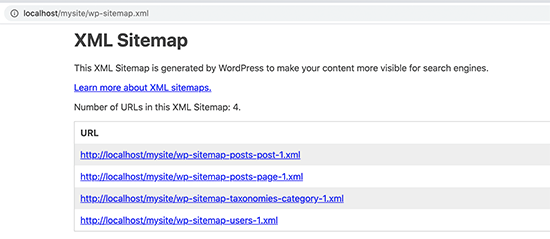
Esta función de sitemap XML se agregó a WordPress para asegurar que cualquier sitio web nuevo de WordPress no se pierda los beneficios SEO de un sitemap XML.
Sin embargo, no es muy flexible y no puedes controlar fácilmente qué agregar o eliminar de tus mapas del sitio XML. Tampoco tiene funciones avanzadas como notificar automáticamente a los motores de búsqueda de inmediato cuando publicas contenido nuevo.
Por suerte, casi todos los plugins SEO para WordPress más importantes vienen con su propia funcionalidad de mapa del sitio. Estos mapas del sitio son mejores y puedes controlar qué contenido eliminar o excluir de tus mapas del sitio XML de WordPress.
Método 2: Crear un mapa del sitio XML en WordPress usando AIOSEO
La forma más fácil de crear un mapa del sitio XML en WordPress es usando el plugin Todo en Uno SEO (AIOSEO) para WordPress.
Es el mejor plugin SEO para WordPress del mercado, que te ofrece un generador de mapas del sitio y un conjunto completo de herramientas para optimizar tus publicaciones de blog para SEO.
Primero, necesitas instalar y activar el plugin Todo en Uno SEO. Para más detalles, consulta nuestra guía paso a paso sobre cómo instalar un plugin de WordPress.
La función de mapa del sitio también está disponible en la versión AIOSEO Gratuita. Sin embargo, para obtener mapas del sitio de noticias avanzados y mapas del sitio de video, necesitarás la versión Pro.
Después de la activación, ve a la página Todo en Uno SEO » Mapas del sitio para revisar la configuración del mapa del sitio.
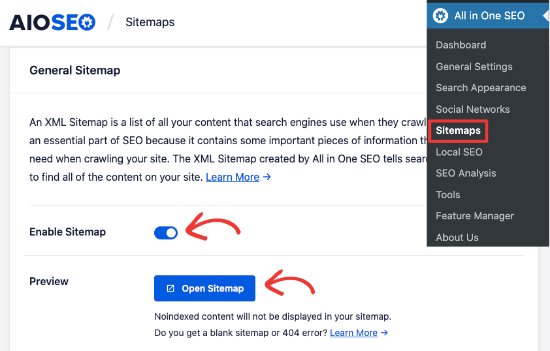
Por defecto, Todo en Uno SEO habilitará la función de Mapa del sitio por ti y reemplazará los mapas del sitio básicos de WordPress.
Puedes hacer clic en el botón 'Abrir mapa del sitio' para previsualizarlo y ver cómo se ve. También puedes ver tu mapa del sitio abriendo una nueva pestaña del navegador y escribiendo sitemap.xml al final de la URL de tu sitio web. Debería verse así:
https://www.example.com/sitemap.xml

Como principiante, no necesitas hacer nada, ya que la configuración predeterminada funcionará para todo tipo de sitios web, blogs y tiendas en línea.
Sin embargo, puedes personalizar la configuración del mapa del sitio para controlar qué quieres incluir en tu mapa del sitio XML.
Simplemente desplázate hacia abajo hasta la sección ‘Configuración del mapa del sitio’.

Esta sección te ofrece opciones para administrar índices de sitemaps e incluir o excluir tipos de publicaciones y taxonomías (<a href="https://www.wpbeginner.com/beginners-guide/categories-vs-tags-seo-best-practices-which-one-is-better/" title="Categorías vs Etiquetas – Mejores prácticas de SEO para organizar tu contenido">categorías y etiquetas). También puedes habilitar sitemaps XML para archivos basados en fechas y archivos de autor.
All in One SEO incluye automáticamente todo tu contenido de WordPress en los sitemaps XML. Pero, ¿qué pasa si tienes páginas independientes como un <a href="https://www.wpbeginner.com/plugins/5-best-contact-form-plugins-for-wordpress-compared/" title="Comparativa de los mejores plugins de formularios de contacto para WordPress">formulario de contacto, una <a href="https://www.wpbeginner.com/plugins/best-wordpress-landing-page-plugins-compared/" title="Comparativa de los mejores plugins de páginas de destino para WordPress">página de destino, o páginas de tiendas de <a title="Shopify" href="https://www.wpbeginner.com/refer/shopify/" target="_blank" rel="nofollow noopener">Shopify que no forman parte de WordPress?
Bueno, AIOSEO es el único plugin que te permite agregar páginas externas a tu sitemap de WordPress. Simplemente desplázate hasta la sección ‘Páginas Adicionales’ y actívala. Esto te mostrará un formulario donde puedes agregar cualquier página personalizada que desees incluir.
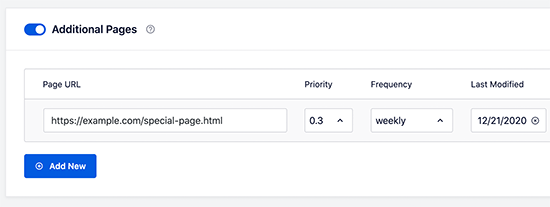
Simplemente necesitas agregar la URL de la página que deseas incluir y luego establecer una prioridad donde 0.0 es la más baja y 1.0 es la más alta. Si no estás seguro, te recomendamos usar 0.3.
A continuación, elige la frecuencia de las actualizaciones y la fecha de última modificación de la página.
Puedes hacer clic en el botón ‘Agregar Nuevo’ si necesitas agregar más páginas.
No olvides hacer clic en el botón ‘Guardar Cambios’ para almacenar tu configuración.
Excluir publicaciones y páginas específicas de tu sitemap XML
All in One SEO te permite excluir cualquier publicación o página de tus sitemaps XML. Puedes hacer esto haciendo clic en la sección ‘Configuración Avanzada’ en la página de All in One SEO » Sitemaps.

También puedes eliminar una publicación o página de tus mapas del sitio XML haciéndola no indexable y no seguida. Esto es útil para contenido que no quieres que aparezca en los resultados de búsqueda, como páginas de 'Gracias', políticas de privacidad o páginas de administración.
Simplemente edita la publicación o página que deseas excluir y desplázate hacia abajo hasta el cuadro de Configuración de AIOSEO debajo del editor.
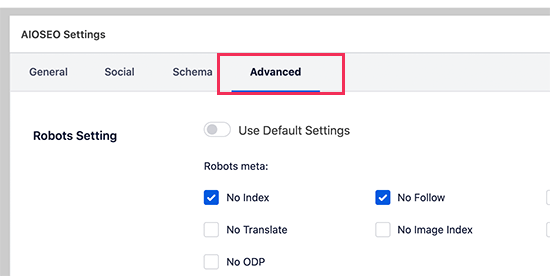
Desde aquí, necesitas cambiar a la pestaña Avanzado y marcar las casillas junto a las opciones 'No Index' y 'No Follow'.
Creación de Sitemaps Adicionales
All in One SEO te permite crear sitemaps adicionales, como un sitemap de video o de noticias.
Puedes crear un sitemap de video si regularmente incrustas videos en tus publicaciones o páginas de blog. Esto permitirá que los motores de búsqueda muestren las publicaciones en los resultados de búsqueda y de búsqueda de videos junto con una miniatura de video.
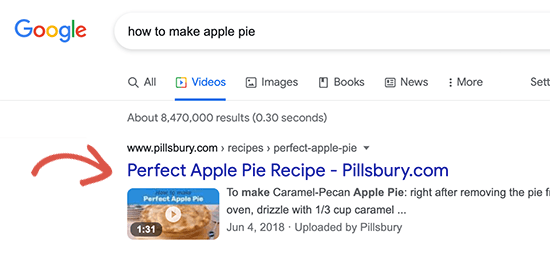
También puedes crear un sitemap de Noticias si tienes un sitio web de noticias y quieres aparecer en los resultados de búsqueda de Google Noticias.
Simplemente ve a All in One SEO » Sitemaps y cambia a las pestañas Video Sitemap o News Sitemap para generar estos sitemaps.
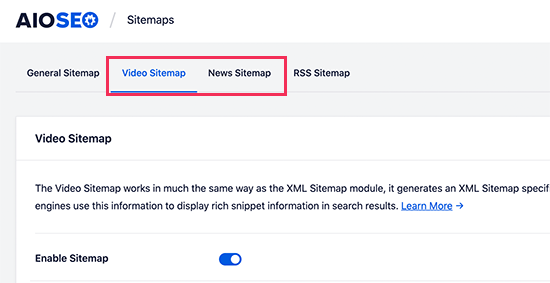
En general, AIOSEO es el mejor plugin de WordPress porque te brinda toda la flexibilidad y potentes funciones a un precio muy asequible.
Método 3: Creación de un XML Sitemap en WordPress usando Yoast SEO
Si estás utilizando Yoast SEO como tu plugin de SEO para WordPress, entonces también activa automáticamente los sitemaps XML por ti.
Primero, necesitas instalar y activar el plugin Yoast SEO. Para más detalles, consulta nuestra guía paso a paso sobre cómo instalar un plugin de WordPress.
Después de la activación, ve a la página SEO » General y cambia a la pestaña 'Características'. Desde aquí, necesitas desplazarte hacia abajo hasta la opción 'XML Sitemap' y asegurarte de que esté activada.

A continuación, haz clic en el botón 'Guardar Cambios' para almacenar tus modificaciones.
Para verificar que Yoast SEO ha creado un mapa del sitio XML, puedes hacer clic en el ícono de signo de interrogación junto a la opción 'Mapas del sitio XML' en la página.
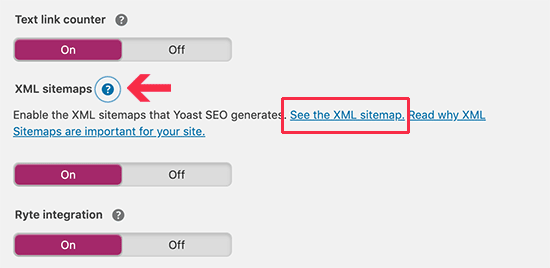
Después de eso, haz clic en el enlace 'Ver el mapa del sitio XML' para ver tu mapa del sitio XML en vivo generado por Yoast SEO.
También puedes encontrar tu sitemap XML abriendo una nueva pestaña del navegador y escribiendo sitemap_index.xml al final de la dirección de tu sitio web. Por ejemplo:
https://www.example.com/sitemap_index.xml
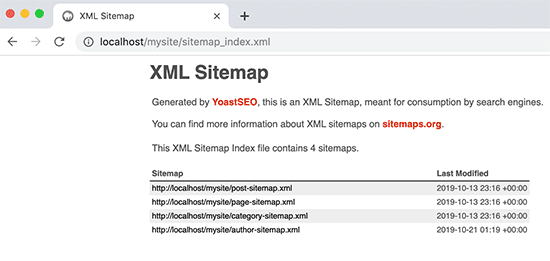
Yoast SEO crea múltiples mapas del sitio para diferentes tipos de contenido. Por defecto, generará mapas del sitio para publicaciones, páginas, autores y categorías.
Envío de tu sitemap XML a los motores de búsqueda
Los motores de búsqueda son bastante inteligentes para encontrar un mapa del sitio. Cada vez que publicas contenido nuevo, se envía una notificación a Google y Bing para informarles sobre los cambios en tu mapa del sitio.
Sin embargo, te recomendamos que envíes el mapa del sitio manualmente para asegurarte de que los motores de búsqueda puedan encontrarlo.
Envío de tu mapa del sitio XML a Google
Google Search Console es una herramienta gratuita ofrecida por Google para ayudar a los propietarios de sitios web a monitorear y mantener la presencia de su sitio en los resultados de búsqueda de Google.
Agregar tu sitemap a Google Search Console ayuda a que descubra tu contenido rápidamente, incluso si tu sitio web es completamente nuevo.
Primero, necesitas visitar el sitio web de Google Search Console y registrarte para obtener una cuenta.
Después de eso, se te pedirá que selecciones un tipo de propiedad. Puedes elegir un dominio o un prefijo de URL. Recomendamos elegir un prefijo de URL ya que es más fácil de configurar.

Ingresa la URL de tu sitio web y luego haz clic en el botón 'Continuar'.
A continuación, se te pedirá que verifiques la propiedad del sitio web. Verás varios métodos para hacerlo. Recomendamos usar el método de etiqueta HTML.

Simplemente copia el código en la pantalla y luego ve al área de administración de tu sitio web de WordPress.
Si estás usando AIOSEO, entonces viene con verificación de herramientas de webmaster fácil. Simplemente ve a All in One SEO » General Settings y luego haz clic en la pestaña 'Webmaster Tools'. Después de eso, puedes ingresar el código de Google allí.

Si no estás usando AIOSEO, entonces puedes ingresar el código usando el plugin WPCode. Esta es la forma más segura y fácil de agregar código a tu sitio de WordPress.
Necesitas instalar y activar el Plugin Gratuito WPCode. Para más detalles, consulta nuestra guía paso a paso sobre cómo instalar un plugin de WordPress.
Al activarlo, debes visitar la página Fragmentos de código » Encabezado y pie de página y agregar el código que copiaste anteriormente en el cuadro 'Encabezado'.
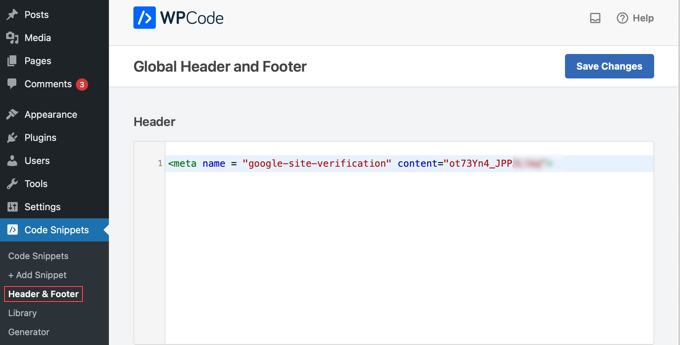
No olvides hacer clic en el botón 'Guardar cambios' para almacenar tus modificaciones.
Una vez que hayas agregado el código a tu sitio usando cualquiera de los métodos anteriores, vuelve a la pestaña de Google Search Console y haz clic en el botón ‘Verificar’.
Google buscará un código de verificación en tu sitio y luego lo agregará a tu cuenta de Google Search Console.
Nota: Si la verificación no tiene éxito, asegúrate de borrar tu caché en WordPress y luego inténtalo de nuevo.
Ahora que has agregado tu sitio web, agreguemos también tu sitemap XML.
Desde el panel de tu cuenta, debes hacer clic en 'Sitemaps' en la columna izquierda.

Después de eso, debes agregar la última parte de la URL de tu sitemap en la sección 'Agregar un nuevo sitemap' y hacer clic en el botón 'Enviar'.
Google ahora agregará la URL de tu sitemap a tu Google Search Console.
Le tomará tiempo a Google rastrear tu sitio web. Después de un tiempo, podrás ver estadísticas básicas del sitemap.
Esta información incluye el número de enlaces que Google encontró en tu sitemap, cuántos de ellos se indexaron, la proporción de imágenes a páginas web y más.
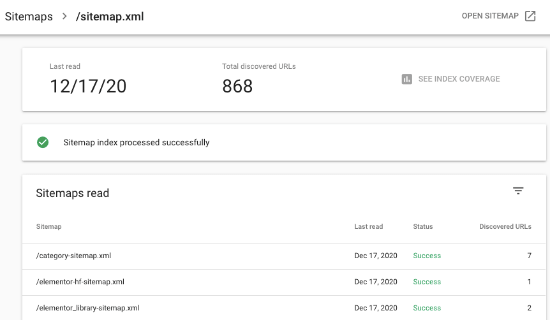
Envío de tu sitemap XML a Bing
Similar a Google Search Console, Bing también ofrece Bing Webmaster Tools para ayudar a los propietarios de sitios web a monitorear su sitio en el motor de búsqueda de Bing.
Para agregar tu sitemap a Bing, debes visitar el sitio web de Bing Webmaster Tools.
Aquí, verás dos opciones para agregar tu sitio. Puedes importar tu sitio desde Google Search Console o agregarlo manualmente.

Si ya has agregado tu sitio a Google Search Console, te sugerimos importar tu sitio. Ahorra tiempo ya que tu sitemap se importará automáticamente.
Si eliges agregar tu sitio manualmente, debes ingresar la URL de tu sitio y verificar el sitio.
Bing ahora te pedirá que verifiques la propiedad de tu sitio web y te mostrará varios métodos para hacerlo.
Recomendamos usar el método de la etiqueta Meta. Simplemente copia la línea de la etiqueta meta de la página y dirígete a tu panel de WordPress.
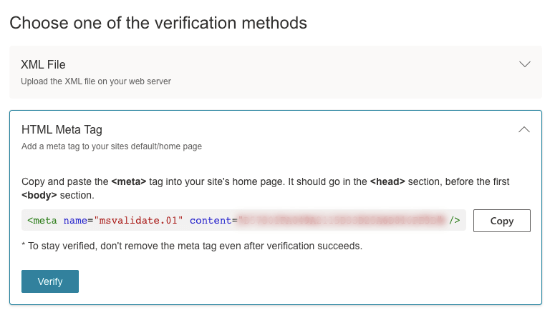
Ahora, instala y activa el plugin gratuito WPCode en tu sitio web
Tras la activación, debes visitar la página Code Snippets » Header & Footer y añadir el código que copiaste anteriormente en el cuadro 'Header'.

No olvides hacer clic en el botón 'Guardar cambios' para almacenar tus modificaciones.
Uso de sitemaps XML para hacer crecer tu sitio web
Ahora que ha enviado el sitemap XML a Google y Bing, veamos cómo utilizarlo para su sitio web.
Primero, debe tener en cuenta que el sitemap XML no mejora sus clasificaciones de búsqueda. Sin embargo, ayuda a los motores de búsqueda a encontrar contenido, ajustar la tasa de rastreo y mejorar la visibilidad de su sitio web en los motores de búsqueda.
Debes estar atento a las estadísticas de tu sitemap en Google Search Console. Puede mostrarte errores de rastreo y las páginas excluidas del informe Indexación » Páginas (anteriormente conocido como Cobertura).
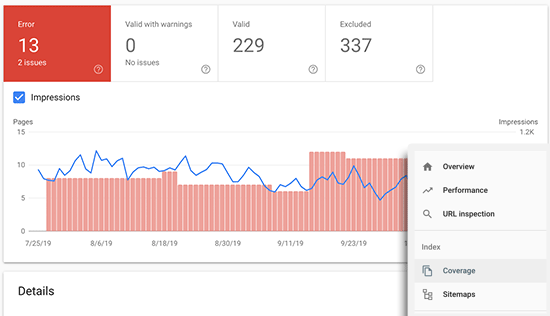
Debajo de los gráficos, puede hacer clic en las diferentes tablas.
Aquí, puedes desplazarte hacia abajo hasta la sección ‘Por qué las páginas no están indexadas’ para ver qué URLs específicas han sido excluidas o no indexadas por Google.

Normalmente, Google puede decidir omitir contenido duplicado, páginas sin contenido o con muy poco contenido, y páginas excluidas por el archivo robots.txt de su sitio web o etiquetas meta.
Sin embargo, si tiene un número inusualmente alto de páginas excluidas, es posible que desee verificar la configuración de su plugin de SEO para asegurarse de que no está bloqueando ningún contenido.
Para más detalles, consulte nuestra guía completa de Google Search Console para principiantes.
Tutorial en video
Preguntas frecuentes sobre mapas del sitio XML
Recibimos muchas preguntas de nuestros lectores sobre cómo funcionan los sitemaps y por qué son necesarios. Aquí están las respuestas a algunas de las preguntas más comunes.
1. ¿Cómo encuentro mi sitemap XML en WordPress?
La forma más fácil de encontrar tu sitemap es abrir una pestaña del navegador y agregar sitemap.xml o sitemap_index.xml al final del nombre de dominio de tu sitio web. Ten en cuenta que es posible que veas una lista de sitemaps (como categorías, publicaciones, páginas) en lugar de una lista de URLs. Esto es normal y se llama un Índice de Sitemaps.
2. ¿Cuál es la diferencia entre un sitemap HTML y un sitemap XML?
Un sitemap HTML está diseñado para visitantes humanos. Suele ser una página sencilla que enumera enlaces a tus publicaciones y páginas para ayudar a los usuarios a navegar por tu sitio. Un sitemap XML está escrito específicamente para los bots de los motores de búsqueda. Contiene código que ayuda a los rastreadores a comprender la estructura de tu contenido.
3. ¿Realmente necesito un sitemap para un sitio web pequeño?
Técnicamente, los sitios web muy pequeños con un enlazado interno perfecto podrían ser rastreados sin uno. Sin embargo, recomendamos encarecidamente crear uno independientemente del tamaño de tu sitio. Solo toma unos minutos configurarlo y garantiza que Google sepa que tus páginas existen.
4. ¿Tener un sitemap XML mejora mis rankings SEO?
Un mapa del sitio no mejora directamente tus rankings de búsqueda. Sin embargo, ayuda a que tu contenido se indexe más rápido. Tu contenido no puede aparecer en los resultados de búsqueda si Google no lo ha indexado, por lo que un mapa del sitio sigue siendo importante para tu estrategia de SEO.
5. ¿Cómo excluyo una página de mi mapa del sitio XML?
Puedes excluir una página configurándola como 'noindex' en la configuración de tu plugin de SEO.
En AIOSEO, puedes hacer esto en el cuadro de configuración Avanzada mientras editas cualquier publicación o página. Una vez que una página se establece como noindex, se elimina automáticamente del mapa del sitio para que los motores de búsqueda no pierdan tiempo rastreándola.
Recursos adicionales
Esperamos que este artículo te haya ayudado a aprender sobre los mapas del sitio XML y cómo crear un mapa del sitio XML para tu sitio de WordPress. También puedes consultar estos recursos adicionales:
- Guía definitiva de SEO para WordPress para principiantes (Paso a paso)
- Cómo agregar tu sitio de WordPress a Google Search Console
- Cómo agregar tu sitio web a Bing Webmaster Tools
- Cómo Comprobar Si las Publicaciones de Tu Blog de WordPress Están Posicionándose para las Palabras Clave Correctas
- Cómo pedirle a Google que vuelva a rastrear las URL de su sitio de WordPress
Si te gustó este artículo, suscríbete a nuestro canal de YouTube para obtener tutoriales en video de WordPress. También puedes encontrarnos en Twitter y Facebook.





Christopher Ebling
Solo obtengo opciones que dicen "Panel de control", "Consola de búsqueda" y "Go Premium". No veo "mapa del sitio" como una opción. ¿Cómo hago para que haga el mapa del sitio? ¿Tengo que pagar los $97?
Soporte de WPBeginner
Hola Christopher,
La opción se trasladó a las páginas de configuración avanzada. Por favor, consulta nuestra guía actualizada sobre cómo instalar y configurar el plugin Yoast SEO plugin y revisa el paso 3, que muestra cómo habilitar la configuración avanzada, y luego el paso 9, que muestra cómo habilitar los sitemaps.
Administrador
Deepika Bisht
Yoast SEO es la mejor manera de crear un buen sitemap para un blog de WordPress. Gracias por compartirlo.
Mahmoud
Ya tengo mi sitemap XML, pero necesito regenerarlo.
¿Cuál es la mejor manera de hacerlo?
chittara
¡¡¡OMG, me ayudó muchísimo y muchísimo... muchas gracias!!!
Shane Jackson
¡Gracias, esto ayudó mucho!
Vin Boris
Contenido muy informativo. Es buena información con buen conocimiento, la mayoría de mis dudas se aclararon con esto.
Justin Lanouette
¿Cómo se agrega un sitemap a los sitios de wordpress.com?
Abdul Asif
¿Puedes explicar qué debe incluirse en los sitemaps, si todas las publicaciones, categorías, etiquetas, etc..?
Angela - CRD Founder
¡Artículo increíble! Nadie podría explicar lo del Sitemap mejor que tú. ¡¡Muchas gracias!! Acabo de seguir todos los pasos (para el método de verificación, elegí "Proveedor de nombres de dominio", por cierto)
Mi sitio web tiene aproximadamente un mes y acabo de agregar el plugin YOAST y el sitemap hoy. ¿Cuánto tiempo tarda Google en reconocerlo? Ahora mismo, tengo este mensaje en mis Herramientas para webmasters:
"Detalles del error: 1 errores, 0 advertencias.
"Encontramos un error al intentar acceder a tu Sitemap. Asegúrate de que tu Sitemap sigue nuestras directrices, se puede acceder a él en la ubicación que proporcionaste y luego vuelve a enviarlo.
"Red inalcanzable: Red inalcanzable"
¿Qué significa, por favor?
andy
¡Gracias! ¡Esto es genial!
Valentine
No tengo nada más que comentar porque el proceso fue directo. Muchas gracias.
Soporte de WPBeginner
De nada.
Administrador
Toma
Para empezar, me gustaría decir "gracias" por todo su apoyo y orientación a los nuevos usuarios de WP.
He creado un sitemap, sin embargo, Google me dice que la URL está restringida por robots.txt
Mi archivo robots.txt se ve así:
User-agent: * Disallow: /
Sitemap: http://www.example.com/sitemap.xml
Comprobaciones:
sitemap.xml ha sido probado y está funcionando como se esperaba.
He revisado las variantes del sitio (www y sin www)
Entiendo que en el Panel de WordPress, bajo Visibilidad en buscadores, es posible animar a los motores de búsqueda a indexar el sitio. Mi entendimiento es que al hacerlo se modificará el archivo robots.txt y permitirá que todos los robots rastreen mi sitio, incluidos los rastreadores "malos" (he leído esto en otros tutoriales).
Cualquier ayuda adicional será muy apreciada.
Saludos,
Toma.
Soporte de WPBeginner
Tu archivo Robots.txt está bloqueando a los motores de búsqueda. Necesitas cambiar eso inmediatamente. Intenta esto y luego verifica de nuevo con las herramientas para webmasters de Google.
User-agent: *
Disallow:
SITEMAP: http://www.example.com/sitemap.xml
Administrador
danielsonjosh
¡Esto es fabuloso!!!!!! Gran trabajo
Abhinav
La página del sitemap de Yoast muestra "Advertencia: La clase __PHP_Incomplete_Class no tiene unserializer en /home/content/n3pnexwpnas01_data02/78/3160178/html/wp-content/object-cache.php en la línea 520", seguido de urls. Este es el caso tanto con sitemap_index como con los sitemaps contenidos en él. A veces muestra el formato correcto y a veces el mismo error para la misma publicación/página/índice del sitemap. ¿Cómo puedo solucionar esto?
Quanglepro
Hola,
Tu consejo es muy detallado. Pero, ¿puedo preguntar algo más? Soy un nuevo usuario de WordPress de Vietnam, me encuentro con el problema del sitemap de Yoast SEO.
Después de guardar los cambios en el Mapa del sitio de Yoast, luego voy a la consola de Google para agregar "sitemap_index.xml" para indexar.
Después de agregar sitemap_index.xml, solo muestra la columna de color azul, no tiene ninguna columna de color rojo para Indexación.
¿Es APROBADO o FALLIDO? ¿Cómo puedo saber si la consola de Google indexó mi mapa del sitio o no lo indexó en este caso?
Buen día
Quangle
Soporte de WPBeginner
Si hay un error, Google mostrará el error. De lo contrario, deberías ver tu sitemap aceptado.
Administrador
Quanglepro
Está hecho, señor. Después de 2 días, estará indexado. Google no indexa inmediatamente.
Buen día.
ArParvez
Estimado señor, estoy viendo su video y tutorial, usando cómo hacer SEO en WordPress y Toast. Lo he hecho, pero cuando intento ver el archivo XML me dice error/página no encontrada, pero cuando pruebo este enlace en el sitemap de Google dice que no hay error, pero está vacío. ¿Qué debo hacer? Y también estoy teniendo problemas usando WordPress, creo que cometí algún error al instalar WP. Lo instalé a través de un teléfono Android. Y a veces, cuando quiero eliminar algún plugin, me dice error de base de datos, ¿pueden ayudarme a reinstalar WordPress por favor? Se lo agradecería mucho. Gracias.
Soporte de WPBeginner
Parece que WordPress no puede conectarse al servidor de la base de datos. Por favor, echa un vistazo a nuestra guía sobre cómo solucionar el error de conexión a la base de datos en WordPress.
Alessio
Hola chicos,
¿todavía necesito un plugin dedicado para el sitemap o la última versión de WP viene con algo para el sitemap también?
Soporte de WPBeginner
WordPress no viene con sitemaps integrados.
Administrador
suji
¡Después de instalar el plugin Yoast, recibí el siguiente mensaje!
Se ha detectado el plugin Yoast SEO. ¿Desea importar su configuración a All in One SEO Pack?
¿Qué necesito hacer?
Soporte de WPBeginner
Necesitas deshabilitar el plugin All in One SEO. Yoast SEO y All in One SEO son ambos plugins SEO. Tener ambos habilitados en tu sitio puede causar problemas graves.
Administrador
Suji
Hola,
Gracias por la respuesta. Deshabilité el plugin All in one SEO. Tengo una consulta más. ¿Puedes responderla, por favor?
Ya verifiqué mi sitio usando el método de carga de archivo HTML, así que ahora, ¿cómo puedo generar un sitemap usando el plugin Yoast SEO?
Brisa de Verano
¡Muchas gracias! Esto fue inmensamente útil.
Jacqui Rawson
¡Gracias, chicos!
Esto fue de gran ayuda.
Están haciendo que mis niveles de estrés disminuyan inmensamente con toda su ayuda para configurar mi sitio de SEO.
¡Saludos!
Emma
Gracias por las instrucciones paso a paso, realmente me ayudaron a entender mejor WP y Google.
¡Sigan con el buen trabajo!
Abhyank
“Si tienes un sitemap ubicado en example.com/sitemap.xml, tu sitemap no está siendo generado por nuestro plugin Yoast SEO. Probablemente está siendo generado por Google XML Sitemaps u otro plugin de sitemaps XML. Por favor, deshabilita otros plugins de sitemaps y elimina cualquier archivo de sitemap vía FTP antes de habilitar los sitemaps en nuestro plugin.”
¿Cómo soluciono esto?
Soporte de WPBeginner
Simplemente ve a tu página de plugins. Busca si tienes instalado algún plugin que agregue sitemaps XML. Si es así, deshabilita ese plugin.
Administrador
Abhyank
Realmente no puedo saber si alguno de mis plugins está creando un sitemap, no creo haber instalado ninguno que lo haga. Estoy terriblemente confundido.
Soporte de WPBeginner
Entonces intenta deshabilitar todos los plugins excepto Yoast SEO. Luego intenta ir a sitemaps, si no ves el mensaje, significa que uno de los plugins estaba causando el problema. Luego puedes activar los plugins uno por uno y visitar la pantalla de sitemaps para ver si el error reaparece. Haz eso hasta que encuentres el plugin que lo está causando.
Por otro lado, si ves el mensaje incluso después de desactivar todos los plugins, entonces podría ser tu tema de WordPress o un archivo creado manualmente en tu servidor.
Yuvraj Khavad
Hola,
Gracias por este tutorial.
Publicación muy informativa.
Gracias
Yuvraj Khavad
Dawit
¡Gracias! Muy útil.
Erin
Gracias por este artículo informativo.
He notado que algunas de mis páginas no están incluidas en el mapa del sitio generado en Wordpress usando la herramienta Yoast SEO – Mapa del sitio XML. ¿Hay alguna forma de ingresar manualmente las páginas faltantes o de actualizar el mapa del sitio para incluir estas páginas?
Galib
¡¡Muy fácil de seguir y crear un sitemap!!
Jo
¡Gracias! Creo que he creado lo que se necesitaba y fue fácil. Las instrucciones fueron claras y fáciles de seguir, gracias.
Annika
Hola,
He leído muchas páginas tratando de explicar lo que hiciste, pero en serio, el tuyo es DE LEJOS el mejor. Fácil de entender, explicaciones paso a paso. Gracias por tu gran ayuda, probablemente me ahorraste horas y horas de trabajo.
Saludos,
Annika
Soporte de WPBeginner
Gracias, nos alegra que te haya resultado útil.
Administrador
Magaly
Great info, very useful!

Now will wait for Google Analitycs to do his work
Suraj
¡Artículo muy útil y las capturas de pantalla lo hacen fácil de entender! ¡Gracias por publicarlo!
kksilvery
Hola,
Fue fácil de entender. Mi pregunta es, ¿cómo puedo editar el mapa del sitio actual de mi blog?
Saludos,
kksilvery.
Kay Collier
Gracias una vez más por más información valiosa.
Josh Watson
¡Artículo súper útil! ¡Realmente aprecio la información! Esto me ahorró mucho tiempo y molestias. Había mirado un par de otras guías y eran simplemente confusas.
¡Usé esto en mi sitio y realmente nos salvó!
Shailesh Jangra
Hola Syed Balkhi,
Gran publicación sobre sitemaps. Tengo una pregunta para ti.
Tengo sitemap_index.xml para mi sitio web (sin www), pero ahora configuré mi sitio web a la versión www. Puedo ver que todas las páginas cambian automáticamente con la versión www, pero sitemap_index no. ¿Alguna razón específica?
Además, no muestra nada en, pero en la página sitemap_index.xml tengo el sitemap completo.
¿Cuál es el error?
Soporte de WPBeginner
Dado que has configurado la URL de tu sitio web en www, tu sitemap se publicará en la misma URL.
Administrador
zeeshan khan
Mi mapa del sitio muestra las estadísticas de la página web, pero no muestra las estadísticas de las imágenes. ¿Por qué no se muestran las imágenes en mi mapa del sitio? Ayúdame por favor.
Tom Horn
Cada vez que envío el sitemap, este es el mensaje que recibo:
"Tu Sitemap no contiene ninguna URL. Por favor, valida y vuelve a enviar tu Sitemap."
¿Puedes decirme qué hacer? Gracias.
Leo
He tenido problemas serios con los sitemaps desde hace unos meses. Estoy usando WordPress alojado por GoDaddy. He instalado SEO by Yoast y seguí el tutorial de sitemaps que tenías. El sitio se está conectando, el sitemap está ahí, pero los enlaces específicos (publicaciones, páginas, autor, etc.) están pendientes.
Esperamos 48 horas y nada. Lo intentamos muchas veces, lo reenviamos, y aún así Google Search Console no está rastreando nuestro sitio correctamente.
¡No sé qué hacer! ¿Tiene que ver con nuestro tema? Godaddy nos dijo que no hay nada que lo bloquee de su lado. Y cada vez que busco en internet, mucha gente sigue teniendo el mismo problema. Notamos que nuestro sitio está funcionando correctamente y los feeds también. Pero no estamos rastreando nada... Por favor, si alguien ya resolvió esto, díganoslo, tal vez alguien más vaya a resolver este terrible problema
Jess @ Make and Do Crew
¡Gracias por esto! Es la explicación más clara que he visto. ¿Cuánto tiempo tarda Google en rastrearlo? No parece que pueda llegar a la visualización final que mostraste con el número total de páginas e imágenes indexadas, aunque no he recibido ningún tipo de mensaje de que Google todavía esté trabajando en ello. Por ejemplo, ¿debería volver a revisar mañana? Y si es así, ¿puedes decirme exactamente en qué hacer clic para encontrar la confirmación de que el sitio ha sido rastreado por completo? ¡Gracias de nuevo!
Soporte de WPBeginner
Dale al menos 48 horas.
Administrador
John
Gracias por la información. Como adición: si la URL del sitemap devuelve un 404, intenta reducir el valor predeterminado de 1000 para el número máximo de líneas. A mí me funcionó.
Tamsin
Gracias por tu solución. Cambié el valor predeterminado a 200 y funciona. He pasado la última semana tratando de entender esto siendo un principiante total. Me has salvado la cordura.
Israel
por favor, después de hacer clic en el Sitemap XML
lo que obtengo es un error,
Error 404 No encontrado
¡Oops! No pudimos encontrar esta página.
Por favor, revisa tu URL o usa el formulario de búsqueda a continuación.
Por favor, ¿qué puedo hacer para obtener mi sitemap? Gracias
Taranpreet Singh
El mismo problema tengo yo. ¿Has resuelto el problema?
Austin
Mismo problema, sin sitemap en mi sitio gratuito .wordpress.com. ¿Cómo solucionamos esto o creamos uno?
ramin ziafat
gracias, fue genial
surya teja
gracias por el gran artículo.
Tengo un problema. Estoy usando WordPress gratuito con el nombre (sitename.wordpress.com de dominio gratuito) no entiendo cómo agregar el mapa del sitio ahora
Soporte de WPBeginner
Por favor, consulta nuestra guía sobre la diferencia entre WordPress.com y WordPress.org.
Administrador
Nitika
¡buen artículo! aparte de esto, ¿necesitamos ingresar el código de autorización de Google?
Leo
Hola,
Muchas gracias por las instrucciones fáciles de seguir y el tema bien explicado sobre los sitemaps.
Mi pregunta es cómo agregar una página o publicación 'única' que muestre todas tus publicaciones. Espero que entiendas lo que quiero decir.
Vi un blog, en la parte inferior de la página hay un enlace en el que se puede hacer clic llamado 'sitemap'. cuando haces clic en él, te lleva a una página que contiene todas las publicaciones o artículos publicados o, supongo, 'los sitemaps'.
¿Cómo puedo hacer este tipo de 'enlace en el que se puede hacer clic'???
Muchas gracias.
Soporte de WPBeginner
Puedes probar este plugin.
Administrador
Naveen
¡Buen artículo! Pero cuando envié el sitemap, se muestran 0 URL enviadas en el área del panel.
Kris letcher
Gracias por la información concisa.
Kris
Deb Slater
Wow. wpbeginner es la mejor instrucción que he encontrado para mi sitio de Wordpress. Gracias.
Harrison Okoyibo
Solo quiero decir un gran "¡GRACIAS!" por sus esfuerzos al proporcionar a los usuarios de internet de WordPress información, artículos y tutoriales útiles y relevantes. Les deseo a usted y a su equipo más bendiciones de Dios. ¡Shalom!
Luigi
Thank you for this tutorial! It was really helpful!
Ana
¡Gracias por tu tutorial e información! Realmente me ayudó con el sitemap. ¡Gran trabajo!
Ezekiel
Gracias por esta explicación. De hecho, estoy agradecido por ella.
Tus tutoriales en este sitio siempre han sido útiles
Kaleem Ullah
Tu Sitemap parece ser una página HTML. Por favor, usa un formato de sitemap compatible en su lugar. Necesito ayuda